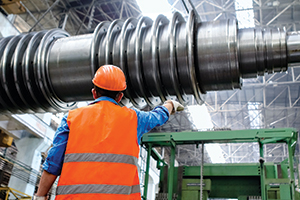
Posted to News on 22nd Apr 2021, 00:00
Successful wireless sensor installation
Thrree steps for a successful wireless sensor installation, detailed by tom Lilly, application engineer at Mantracourt.

As the number of devices connected to the Internet of Things (IoT) grows, so does the need for reliable yet easily deployable sensors. Luckily, wireless sensor technology is evolving, providing manufacturers with practical and cost-effective solutions to monitor the performance of their equipment. However, to reap the full benefits of wireless technology, there are a few important steps to follow during set up.
1. Undertake a site survey: A sensor’s signal strength and data capture capabilities should be assessed on-site. To do this, after ensuring that the sensor is in place and transmitting, the site can be explored with a receiver, such as one of Mantracourt’s T24 handheld receivers.
This allows users to identify any dead spots and plan their layout accordingly. It’s important to remember that the ground can absorb a large portion of the signal, so both the transmitter and the receiver should be located above ground.
Other obstacles, such as concrete or brick walls, metal cladding, ironwork, metal meshes up to 100mm thick, and, surprisingly, trees in leaf that contain a lot of water, can impact the signal strength. If additional coverage is required, a repeater can help extend the sensor’s range and bypass obstacles. It’s also important to consider the presence of future obstacles that might not be present during the installation – for example, you wouldn’t want to position a wireless sensor behind a spot where lorries often park, or along a train track.
Radio interference is usually not a concern, because licensed low power devices that use transmission formats such as 2.4GHz are surprisingly tolerant to common interference sources. However, having multiple sensors can block or slow transmission data, particularly if they are on the same channel. For this reasons, Mantracourt’s T24 products have an error checking function to ensure that data is transmitted correctly. As well as using a clear channel, users can easily configure the rate at which data is sent to reduce the competition for bandwidth between transmitting sensors.
2. Extend your sensor’s lifespan: Wireless sensors can spend most of their life in low power mode and activate to record measurements and transmit data when needed, meaning that their internal battery can last for several years. However, in some instances when faster transmission rates are necessary and no permanent supply is available, manufacturers can use a solar panel or energy harvesting system such as Mantracourt’s Power Pack 1 and Solar Panel 1.
For sensors that operate in particularly harsh environments, an enclosure can prevent damage from water or aggressive chemicals. This is why each of Mantracourt’s wireless transmitter modules can be ordered in one of three IP rated enclosures. When choosing or designing an enclosure, it’s important to remember that the radio signal will need an aperture to escape, such as a small fibreglass window. Users should also remember to tighten up any cable glands and use a drip loop when connecting cables to sensors, transmitter and repeaters to prevent moisture from entering.
3. Think about your data: Storing raw data locally is simple but limits live analytical capabilities. However, thanks to cloud-based remote monitoring platforms like SensorSpace data can be analysed in real-time, allowing you to quickly identify trends and take action when needed. SensorSpace can be used to remotely monitor the live feed from Mantracourt’s T24 wireless telemetry system 24/7, facilitating on-going customer support. Furthermore, the system can be configured to send direct push notifications via SMS and email where necessary.
Following these steps, manufacturers can easily measure variables such as linear movement, wind speed, temperature, loads or torque. The flexibility and ease of installation of wireless sensors means that data can be collected efficiently and cost-effectively, saving money and improving processes in the long run. Also, it allows for more flexibility in ongoing projects where you might only begin with a small number of sensors and increase this down the line. In these situations, you can easily add more wireless sensors, connected to the cloud-based monitoring system, without the need for costly and disruptive cable installations.








